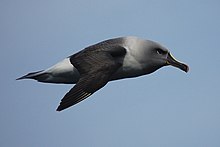
Seabirds are birds that are adapted to life within the marine environment. While seabirds vary greatly in lifestyle, behaviour and physiology, they often exhibit striking convergent evolution, as the same environmental problems and feeding niches have resulted in similar adaptations. The first seabirds evolved in the Cretaceous period, and modern seabird families emerged in the Paleogene.

The black-browed albatross, also known as the black-browed mollymawk, is a large seabird of the albatross family Diomedeidae; it is the most widespread and common member of its family.

The Chatham albatross, also known as the Chatham mollymawk or Chatham Island mollymawk, is a medium-sized black-and-white albatross which breeds only on The Pyramid, a large rock stack in the Chatham Islands, New Zealand (Aotearoa). It is sometimes treated as a subspecies of the shy albatross Thalassarche cauta. It is the smallest of the shy albatross group.

The mollymawks are a group of medium-sized albatrosses that form the genus Thalassarche. The name has sometimes been used for the genus Phoebetria as well, but these are usually called sooty albatrosses. They are restricted to the Southern Hemisphere, where they are the most common of the albatrosses. They were long considered to be in the same genus as the great albatrosses, Diomedea, but a study of their mitochondrial DNA showed that they are a monophyletic taxon related to the sooty albatrosses, and they were placed in their own genus.

Salvin's albatross or Salvin's mollymawk, is a large seabird that breeds mainly on the Bounty Islands of New Zealand, with scant amounts on islands across the Southern Ocean. A medium-sized mollymawk, it was long considered to be a subspecies of the shy albatross.
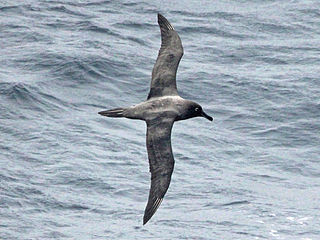
The sooty albatross is a species of marine bird belonging to the albatross family Diomedeidae. It is a medium-sized albatross that sports a sooty-brown or sooty-black color. It can be found in the southern Atlantic Ocean, the southern Indian Ocean, and the Southern Ocean. This bird scavenges for squid, fish, and carrion. Like other albatrosses, these birds mate for life and return to the same breeding spots every season. A single pair will mate every other year on a variety of islands in the southern Atlantic Ocean and the southern Indian Ocean islands. This bird is an endangered species and conservation efforts are taking place.

The shy albatross, also known as shy mollymawk, is a medium-sized albatross that breeds on three remote islands off the coast of Tasmania, Australia, in the southern Indian Ocean. Its lifespan is about 60 years, and it has been seen as far afield as South Africa and the Pacific coast of the United States. As of June 2020, the species is listed as "Endangered" in Australia; there are thought to be 15,000 pairs of shy albatross left. It is Australia's only endemic albatross.
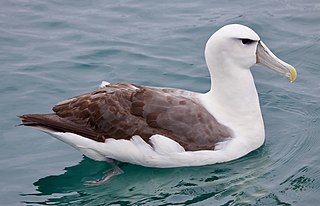
The white-capped albatross is a mollymawk that breeds on the islands off of New Zealand. Not all experts agree that this form should be recognized as a separate species from the shy albatross, Thalassarche cauta. It is a medium-sized black, slate gray, and white albatross and is the largest of the mollymawks.
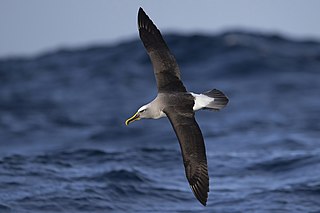
Buller's albatross or Buller's mollymawk, is a small mollymawk in the albatross family.

The Campbell albatross or Campbell mollymawk, is a medium-sized mollymawk in the albatross family. It breeds only on Campbell Island and the associated islet of Jeanette Marie, in a small New Zealand island group in the South Pacific. It is sometimes considered a subspecies of the black-browed albatross. It is a medium-sized black and white albatross with a pale yellow iris.

The Indian yellow-nosed albatross is a member of the albatross family, and is the smallest of the mollymawks. In 2004, BirdLife International split this species from the Atlantic yellow-nosed albatross; however Clements has not split it yet, and the SACC has not either, but recognises the need for a proposal.
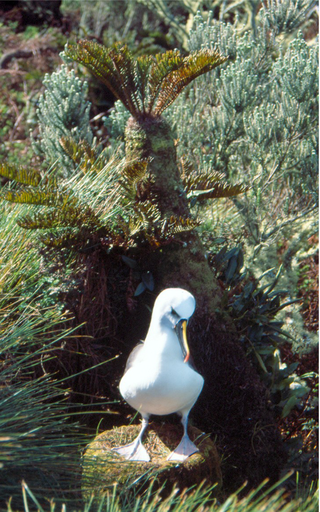
The Atlantic yellow-nosed albatross is a large seabird in the albatross family Diomedeidae.

The Tristan albatross is a large seabird from the albatross family. One of the great albatrosses of the genus Diomedea, it was only widely recognised as a full species in 1998.

Albatrosses, of the biological family Diomedeidae, are large seabirds related to the procellariids, storm petrels, and diving petrels in the order Procellariiformes. They range widely in the Southern Ocean and the North Pacific. They are absent from the North Atlantic, although fossil remains show they once occurred there and occasional vagrants are found. Albatrosses are among the largest of flying birds, and species of the genus Diomedea have the longest wingspans of any extant birds, reaching up to 3.7 m (12 ft). The albatrosses are usually regarded as falling into four genera, but disagreement exists over the number of species.

The white-chinned petrel also known as the Cape hen and shoemaker, is a large shearwater in the family Procellariidae. It ranges around the Southern Ocean as far north as southern Australia, Peru and Namibia, and breeds colonially on scattered islands. The white-chinned petrel was formerly considered to be conspecific with the spectacled petrel.
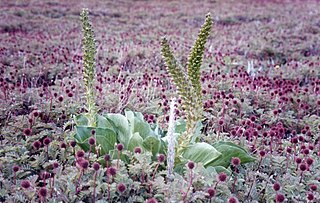
The Southern Indian Ocean Islands tundra is a tundra ecoregion that includes several subantarctic islands in the southern Indian Ocean.

The term seabird is used for many families of birds in several orders that spend the majority of their lives at sea. Seabirds make up some, if not all, of the families in the following orders: Procellariiformes, Sphenisciformes, Pelecaniformes, and Charadriiformes. Many seabirds remain at sea for several consecutive years at a time, without ever seeing land. Breeding is the central purpose for seabirds to visit land. The breeding period is usually extremely protracted in many seabirds and may last over a year in some of the larger albatrosses; this is in stark contrast with passerine birds. Seabirds nest in single or mixed-species colonies of varying densities, mainly on offshore islands devoid of terrestrial predators. However, seabirds exhibit many unusual breeding behaviors during all stages of the reproductive cycle that are not extensively reported outside of the primary scientific literature.




